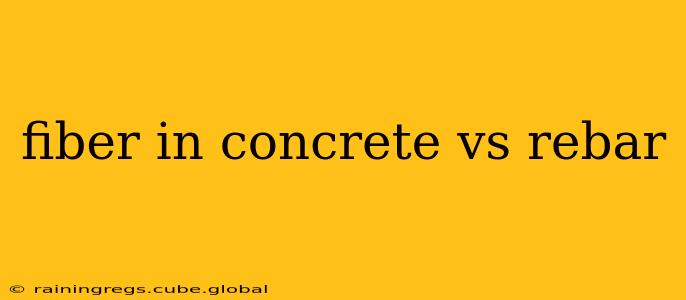Concrete, a ubiquitous construction material, owes its strength and durability to reinforcement. Traditionally, steel rebar (reinforcing bar) has been the go-to solution. However, the introduction of fiber reinforcement, encompassing various materials like steel, glass, and synthetic fibers, offers a compelling alternative and, in certain applications, a superior solution. This article delves into a comprehensive comparison of fiber reinforcement and rebar, examining their properties, applications, and limitations.
What is Rebar?
Rebar, short for reinforcing bar, consists of steel rods or wires embedded within concrete structures. Its primary function is to enhance the tensile strength of concrete, which is inherently weak in tension. Rebar effectively resists cracking and improves the overall structural integrity of the concrete element. The size and spacing of rebar are carefully calculated based on structural engineering principles to withstand anticipated loads.
What are Fibers in Concrete?
Fiber reinforcement in concrete involves dispersing short, discrete fibers throughout the concrete mix. These fibers, which can be made from various materials such as steel, polypropylene, glass, or aramid, enhance the concrete's tensile strength, flexural strength, and impact resistance. Unlike rebar, fibers provide distributed reinforcement, improving crack control and mitigating the propagation of cracks.
Fiber in Concrete vs. Rebar: Key Differences
| Feature | Rebar | Fiber Reinforcement |
|---|---|---|
| Material | Steel | Steel, polypropylene, glass, aramid, etc. |
| Form | Continuous rods or wires | Short, discrete fibers |
| Reinforcement | Localized, point reinforcement | Distributed, throughout the concrete |
| Tensile Strength | High | Moderate to High, depending on fiber type |
| Ductility | High | Moderate to Low, depending on fiber type |
| Cost | Relatively High | Relatively Low to Moderate |
| Installation | More complex, skilled labor required | Simpler, can be automated |
| Crack Control | Effective, but localized | Excellent, distributed crack control |
| Impact Resistance | Moderate | High |
What are the advantages of using fiber reinforcement in concrete?
1. Increased Impact Resistance: Fiber-reinforced concrete excels at absorbing impact energy, making it ideal for applications subject to high impact loads, such as pavements and industrial flooring.
2. Improved Crack Control: The distributed nature of fiber reinforcement leads to finer, more evenly distributed cracks, compared to the larger cracks often seen in rebar-reinforced concrete. This enhances durability and prevents rapid deterioration.
3. Easier and Faster Installation: Fiber reinforcement is simply added to the concrete mix, simplifying installation compared to the more labor-intensive process of placing and tying rebar.
4. Reduced Cost: While the cost depends on the fiber type, fiber-reinforced concrete can often be more economical than rebar-reinforced concrete, particularly for smaller projects or those requiring minimal reinforcement.
5. Enhanced Durability: The improved crack control and impact resistance offered by fibers contribute to a longer lifespan for the concrete structure.
What are the advantages of using rebar in concrete?
1. High Tensile Strength: Rebar offers significantly higher tensile strength compared to most fiber types, making it essential for structures carrying substantial tensile loads.
2. Ductility: Rebar's ability to deform plastically under load provides added safety and resilience in seismic zones or under unexpected overload conditions.
3. Proven Track Record: Rebar has been used for decades and its structural performance is well-understood and established through extensive research and experience.
What are the disadvantages of using fiber reinforcement in concrete?
1. Lower Tensile Strength (compared to rebar): Fiber reinforcement generally provides lower tensile strength than rebar, limiting its suitability for heavily loaded structures.
2. Limited Ductility (compared to rebar): The ductility of fiber-reinforced concrete is lower than that of rebar-reinforced concrete, potentially affecting its behavior under extreme loading conditions.
3. Potential for Fiber Clustering: Improper mixing can lead to fiber clustering, negating the benefits of distributed reinforcement.
What are the disadvantages of using rebar in concrete?
1. High Cost: Rebar is a relatively expensive material, particularly in large-scale projects.
2. Complex Installation: The precise placement and tying of rebar require skilled labor and increases project time and cost.
3. Corrosion Susceptibility: Rebar is vulnerable to corrosion, especially in environments with moisture and chlorides, leading to structural degradation.
Which is better for a specific application? Fiber or Rebar?
The choice between fiber reinforcement and rebar depends on the specific application and its requirements. For structures requiring high tensile strength and ductility, rebar is typically the preferred option. Fiber reinforcement is better suited for applications emphasizing impact resistance, improved crack control, ease of installation, and potentially lower cost.
Frequently Asked Questions (FAQs)
Can fiber reinforcement completely replace rebar?
No, fiber reinforcement is not a direct replacement for rebar in all applications. While it significantly improves concrete's properties, it doesn't match the high tensile strength and ductility of steel rebar in many high-load scenarios. Often, a combination of both fiber and rebar is the optimal solution.
What types of fibers are used in concrete reinforcement?
Several types of fibers are used, including steel fibers, polypropylene fibers, glass fibers, and aramid fibers. Each offers a unique combination of properties, affecting cost and performance.
Is fiber-reinforced concrete more sustainable?
In some cases, yes. The use of recycled materials in fiber production and the potential for reduced cement consumption can contribute to a more sustainable construction approach.
How is fiber reinforced concrete mixed?
Fiber reinforcement is added directly to the concrete mix during batching. Proper mixing techniques are crucial to prevent fiber clustering and ensure uniform distribution throughout the concrete.
This comprehensive comparison of fiber reinforcement and rebar in concrete provides a solid foundation for selecting the appropriate reinforcement technique for any construction project. Remember to always consult with a qualified structural engineer to determine the best reinforcement strategy for specific structural requirements and loading conditions.
